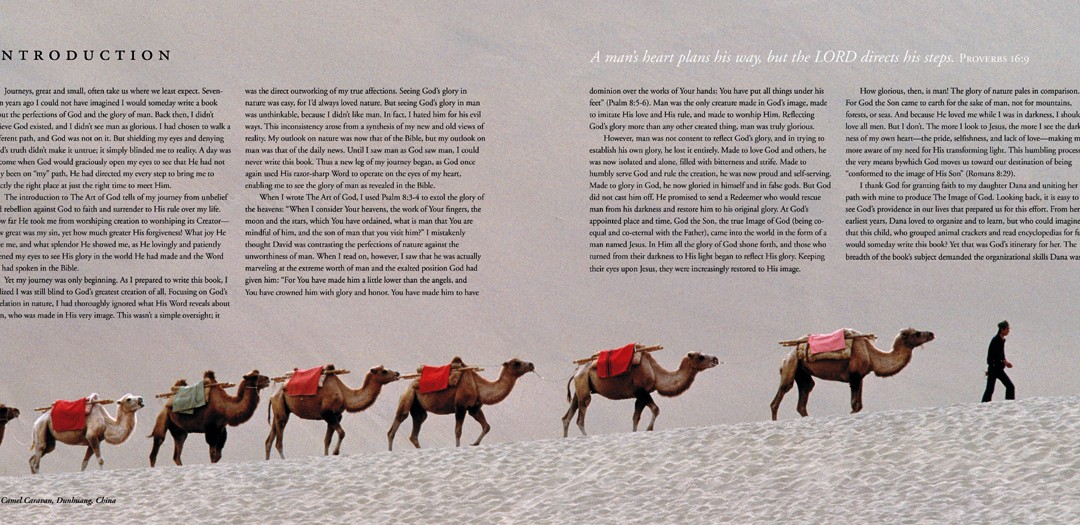A man’s heart plans his way, but the LORD directs his steps. Proverbs 16:9
Journeys, great and small, often take us where we least expect. Seventeen years ago I could not have imagined I would someday write a book about the perfections of God and the glory of man. Back then, I didn’t believe God existed, and I didn’t see man as glorious. I had chosen to walk a different path, and God was not on it. But shielding my eyes and denying God’s truth didn’t make it untrue; it simply blinded me to reality. A day was to come when God would graciously open my eyes to see that He had not only been on “my” path, He had directed my every step to bring me to exactly the right place at just the right time to meet Him.
The introduction to The Art of God tells of my journey from unbelief and rebellion against God to faith and surrender to His rule over my life. How far He took me from worshiping creation to worshiping its Creator—how great was my sin, yet how much greater His forgiveness! What joy He gave me, and what splendor He showed me, as He lovingly and patiently opened my eyes to see His glory in the world He had made and the Word He had spoken in the Bible.
Yet my journey was only beginning. As I prepared to write this book, I realized I was still blind to God’s greatest creation of all. Focusing on God’s revelation in nature, I had thoroughly ignored what His Word reveals about man, who was made in His very image. This wasn’t a simple oversight; it was the direct outworking of my true affections. Seeing God’s glory in nature was easy, for I’d always loved nature. But seeing God’s glory in man was unthinkable, because I didn’t like man. In fact, I hated him for his evil ways. This inconsistency arose from a synthesis of my new and old views of reality. My outlook on nature was now that of the Bible, but my outlook on man was that of the daily news. Until I saw man as God saw man, I could never write this book. Thus a new leg of my journey began, as God once again used His razor-sharp Word to operate on the eyes of my heart, enabling me to see the glory of man as revealed in the Bible.
When I wrote The Art of God, I used Psalm 8:3-4 to extol the glory of the heavens: “When I consider Your heavens, the work of Your fingers, the moon and the stars, which You have ordained, what is man that You are mindful of him, and the son of man that you visit him?” I mistakenly thought David was contrasting the perfections of nature against the unworthiness of man. When I read on, however, I saw that he was actually marveling at the extreme worth of man and the exalted position God had given him: “For You have made him a little lower than the angels, and You have crowned him with glory and honor. You have made him to have dominion over the works of Your hands; You have put all things under his feet” (Psalm 8:5-6). Man was the only creature made in God’s image, made to imitate His love and His rule, and made to worship Him. Reflecting God’s glory more than any other created thing, man was truly glorious.
However, man was not content to reflect God’s glory, and in trying to establish his own glory, he lost it entirely. Made to love God and others, he was now isolated and alone, filled with bitterness and strife. Made to humbly serve God and rule the creation, he was now proud and self-serving. Made to glory in God, he now gloried in himself and in false gods. But God did not cast him off. He promised to send a Redeemer who would rescue man from his darkness and restore him to his original glory. At God’s appointed place and time, God the Son, the true Image of God, came into the world in the form of a man named Jesus. In Him all the glory of God shone forth, and those who turned from their darkness to His light began to reflect His glory. Keeping their eyes upon Jesus, they were increasingly restored to His image.
How glorious, then, is man! The glory of nature pales in comparison. For God the Son came to earth for the sake of man, not for mountains, forests, or seas. And because He loved me while I was in darkness, I should love all men. But I don’t. The more I look to Jesus, the more I see the darkness of my own heart—the pride, selfishness, and lack of love—making me more aware of my need for His transforming light. This humbling process is the very means by which God moves us toward our destination of being “conformed to the image of His Son” (Romans 8:29).
You saw me before I was born. Every day of my life was recorded in your book. Every moment was laid out before a single day had passed. Psalm 139:16 NLT
I thank God for granting faith to my daughter Dana and uniting her path with mine to produce The Image of God. Looking back, it is easy to see God’s providence in our lives that prepared us for this effort. From her earliest years, Dana loved to organize and to learn, but who could imagine that this child, who grouped animal crackers and read encyclopedias for fun, would someday write this book? Yet that was God’s itinerary for her. The breadth of the book’s subject demanded the organizational skills Dana was born with and added to as a history major in college—a facility for extensive research, and the ability to condense voluminous information into a usable form. The complexity of its subject required the skills she has gained as a teacher—the talent to simplify complicated information and convey it in a clear and engaging manner.
The visual nature of the book called for images and experiences from my lifelong journey in the field of photographic travel. Beginning at the age of eight, when my father founded America’s first tour company for “camera fans,” my life was filled with pictures and stories of far-off lands and exotic cultures that stirred my imagination and took me on great flights of fantasy to the ends of the earth. In time those journeys became real, and the pictures and stories were of my own adventures in some of the world’s most beautiful and remote locations. I shot nearly a quarter of a million photographs in the first two decades of my travels, and not one was intended to glorify God. But the designs of a sovereign Creator are not bound by the purposes of created things. As the psalmist says in Psalm 139:16 (NLT), “You saw me before I was born. Every day of my life was recorded in your book. Every moment was laid out before a single day had passed.” Despite my intentions, every picture in this book was directed by God for the purpose of His glory.
The Image of God is unique in its concept and design. Combining the historical narrative of man’s creation, fall, and redemption, with photographs of real people in real places, it presents this vitally important topic in the language of everyday life, not the abstract philosophical terminology of the classroom. This is a true story about real people and the true and living God, not an intangible idea that is disconnected from daily experience. From the beginning, God has communicated His truth to man through images and stories of real-life events. Following His example, using current day pictures of the worldwide family of man, we have endeavored to illustrate the eternal relevance and life-changing power of this story, which is for all people of all nations.
Our journey in creating this book has now come to an end, and yours as the reader is beginning. May God grant you eyes to see His glory in the faces on these pages, illuminated by the light of His Word.



